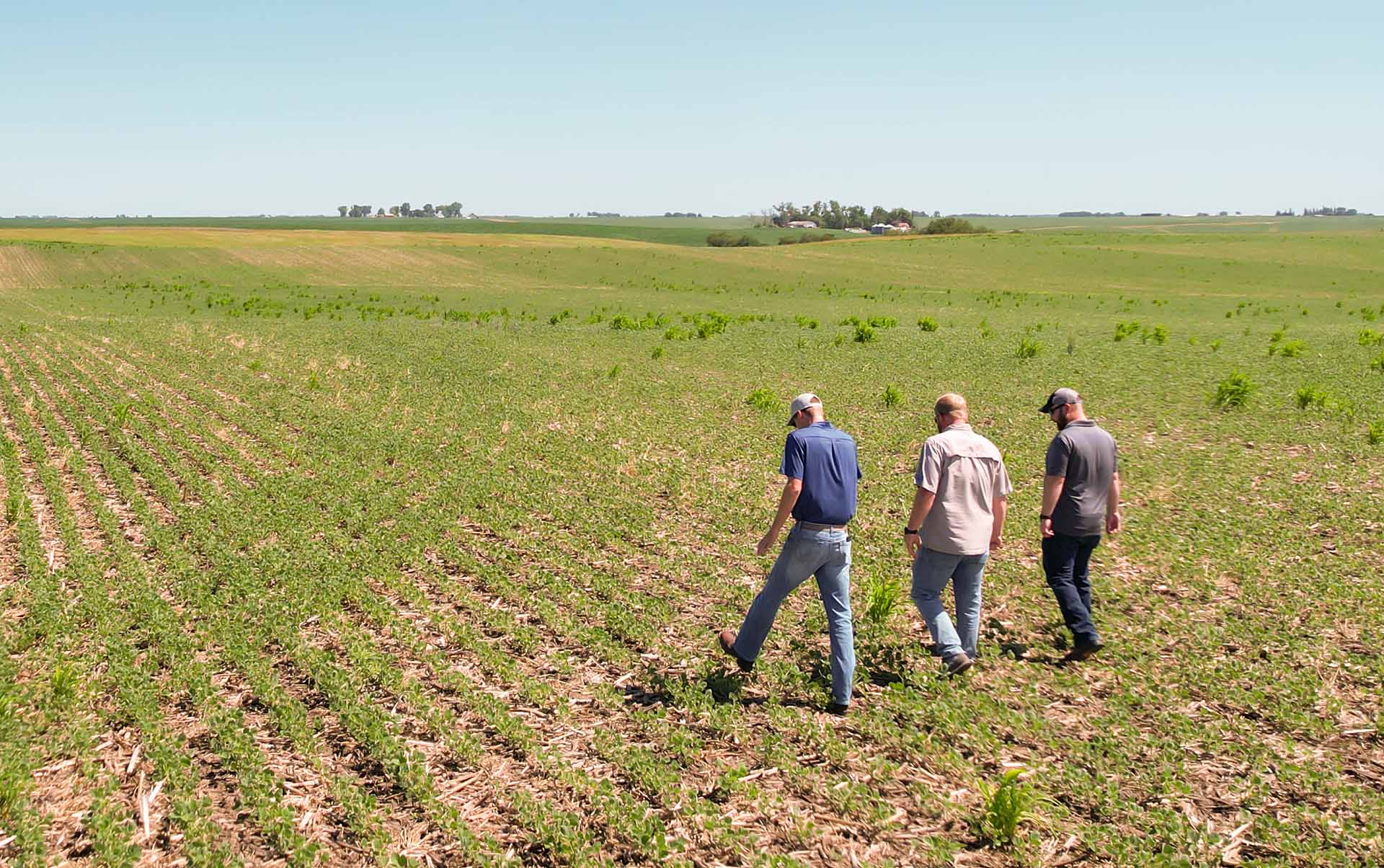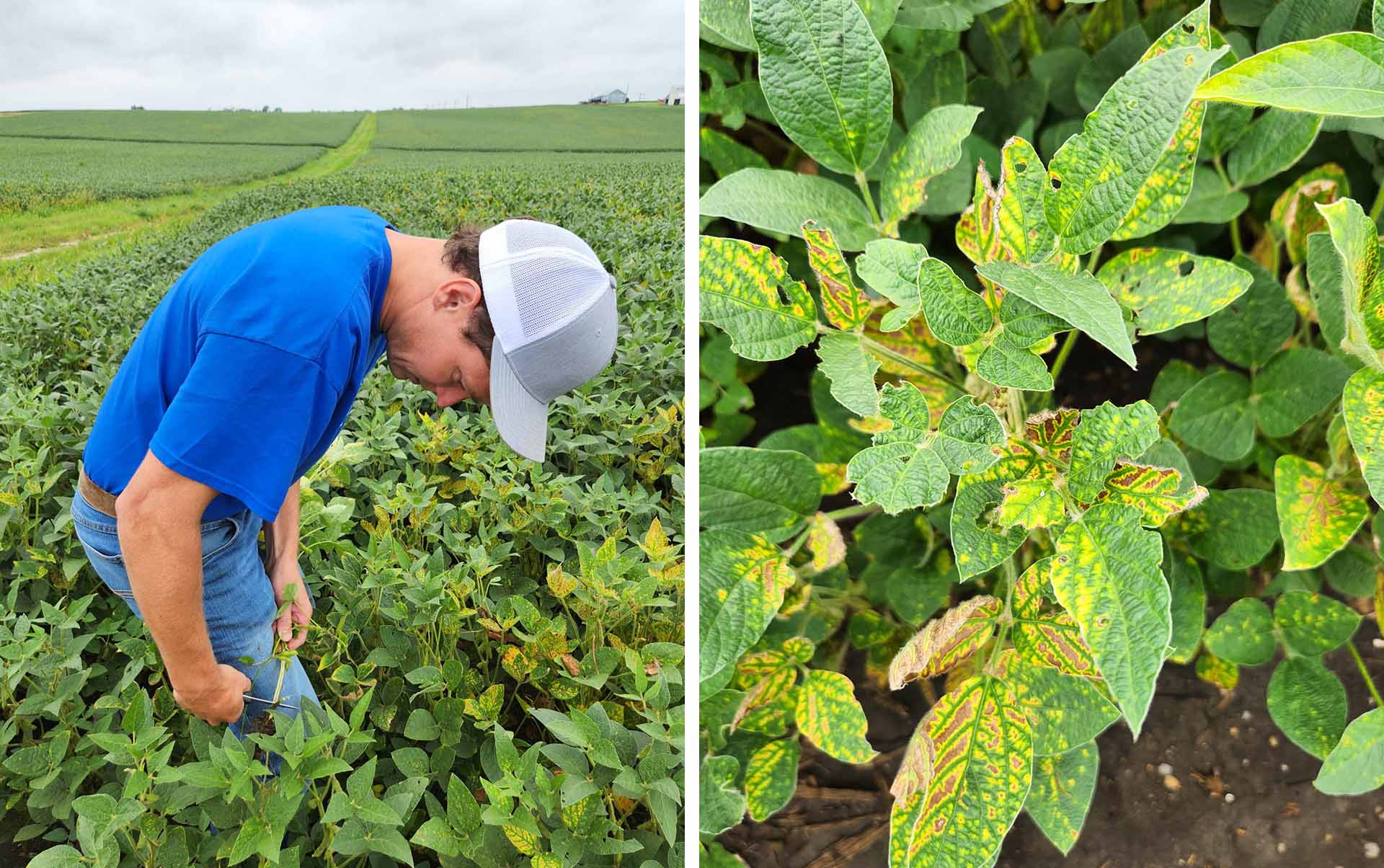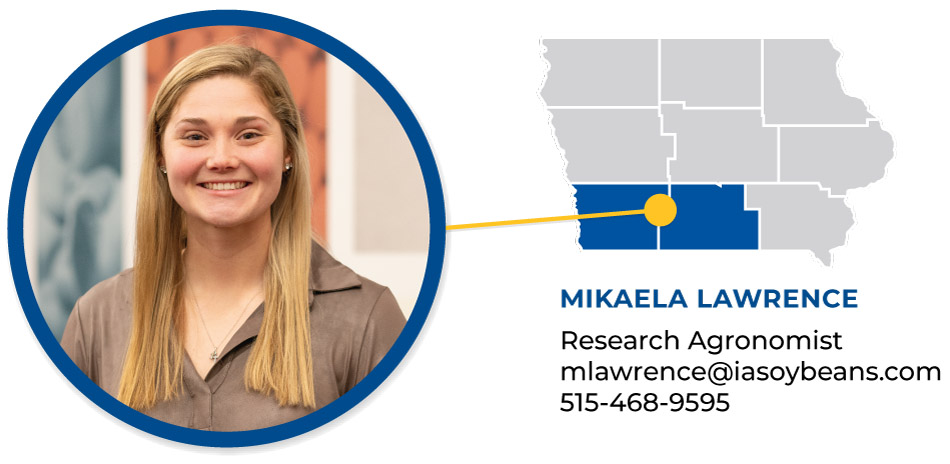
(Photo: Iowa Soybean Association / Joclyn Bushman)
Walking Rows: ISA agronomists update – August 15
August 15, 2024 | Kriss Nelson
Iowa Soybean Association (ISA) research agronomists continue to advise farmers to be on close watch for diseases. The recent cool, wet weather has been the perfect recipe for diseases such as white mold to develop in soybeans and tar spot in corn.
Now is the time to schedule airplanes and drones for aerial cover crop applications. Alex Schaffer, ISA research agronomist, says ISA research shows drones have performed well, especially when applying a blend of cover crop species. Not only do drones fly straight and smooth, but they can also inter-seed into a standing cash crop at the right time before rain and get some early fall establishment and growth.
Drew Clemmensen – Northwest/Western Iowa
Most soybeans have reached the R4-R5 stages in the northwest and western Iowa fields.
Soybean aphid populations have been found in the northern portion of the state, and a few fields have been sprayed. Stay on top of scouting for these insects, as their populations can double in a couple of days.
Weed pressures have continued to be an issue in some fields, with waterhemp escapes throughout the region. After the soybeans reach maturity at the R8 stage, farmers can use some products again as desiccants to suppress weeds and improve harvestability.

There are a few later planted corn fields still in the R2 stage of development, but most corn is well into R3 and R4.
Weather is in the driver’s seat from here on out, but that doesn’t mean you shouldn’t be out in your fields. Ear and stalk rots can surface around this time of development. Using a simple stalk push test or pinch test, you can gain insight into the plant’s ability to stand the rest of the season and decide which fields to harvest first. As always, take notes for reference and identify the required characteristics and traits in varieties for those acres in the future.
Shane Beck – Northeast/Northern Iowa
There have been some reports of soybean aphids being a concern in corn and soybean fields in my area of northern and northeast Iowa. Scouting the field edges will give you a good indication of the presence of aphids in your field.
If you find aphids on the edges of the field, it is key to scout the rest of the field and pull plants to count the number of aphids. The economic injury level for soybean aphids is 250 per plant, with 80% of the plants being infected.
Aphid populations can increase rapidly, so monitoring aphids weekly after identification can help you decide when and if to make an insecticide application.

As we are nearing the last month or so of the growing season, be aware of pre-harvest intervals when applying a fungicide or insecticide. This is the time required between application and harvest. This is 20 to 30 days, but check labels before applying to ensure you understand the interval.
We are also recruiting for fall implemented trials. If you want to try a nitrogen prescription or cover crops, contact me to discuss which trials work best for you.
Alex Schaffer – Central Iowa
Growing Degree Units (GDUs) accumulations show that the crops’ progress is tracking close to last year at this time, just behind by a day or so. One concern is that compared to last year, farmers have planted their crops on a broader range of dates, resulting in varying crop maturity. Cooler weather may have slowed growth, but with warmer weather forecasted, that should help push development.
During a recent Certified Crop Advisors field day, Dr. Daren Mueller, professor and extension plant pathologist at Iowa State University, presented on crop diseases.

This year, their inoculated plots have shown many signs of disease, supporting our claims that conditions are right for disease. A significant takeaway from Mueller’s discussion was avoiding the practice of preventative applications to preserve the efficacy of fungicides. It is important to scout for disease pressure first and then decide to apply a fungicide based on economic thresholds.
Some frogeye leafspot has been appearing in soybean fields, as well as bacterial pustule of soybean and bacterial leaf streak on corn.
For those bacterial diseases, it is important to remember there is no product for treatment; the only tool is a resistant hybrid.
Tar spot has been developing in more cornfields. Yield loss from tar spot occurs around 5% of ear leaf coverage or 400 to 500 spots.
If you notice yellow areas developing in soybean fields, there is a good chance it is Sudden Death Syndrome (SDS). The SDS photo below was taken by Alex Schaffer.

There is also a statewide effort to identify red crown rot. If you spot it, the pathogens likely crossed the river.
The cooler, wet weather brings concerns about white mold. If you have senescent soybean flowers, white mold can infect them. If the weather remains ideal for spore production with a closed soybean canopy, you may see signs of the disease. The only thing you can do is take note and plant a resistant variety the next time you grow soybeans in that field. Other options are cultural practices such as planting in 30-inch rows. Be considerate when moving tillage equipment from field to field this fall if you see a field with white mold.
Compared to the last two years in terms of weather, the advantage of walking your fields this year is seeing what hybrids or varieties are susceptible to these pathogens and taking note.
Now is the time to schedule an airplane or drone for cover crop seeding. If you are considering a cover crop species blend, I advise having a goal in mind when choosing a cover crop blend. One goal I have in mind with a cover crop species blend is to decrease the carbon-to-nitrogen ratio of the shoots and roots as much as possible to make that residue easier to break down.
Consider signing up for a fall Iowa Nitrogen Initiative trial. I have been hearing a lot about the inherent leakiness of the whole nitrogen system, and there are a lot of stewardship opportunities in terms of stabilizers, form and timing. Help to fine-tune your nitrogen program with a five-rate trial.
Lucas DeBruin – Southeast/Eastern Iowa
Since early April, we have accumulated around 2,300 GDUs. Crops planted in mid-May have collected around 2,000 GDUs.
Black layer for corn happens around 2,700 GDUs, and the moisture will still be in the 30% range at that point.
Soybeans have begun to fill pods, and there is no shortage of moisture to be concerned about. If anyone planted early with shorter season hybrids or early varieties, the combines will roll early to mid-September.
Watch the forecast if you want to seed cover crops early with a drone or high-clearance machine. You want to ensure that you get enough rain to germinate and continue to grow; one-tenth of an inch will get seed to germination, and then it will die.

You want to seed into soybeans before all the leaves drop, and they can provide mulch to conserve moisture. You don’t want seed sitting on top of the leaves. For corn, you want at least 50% milk line before seeding.
If broadcast seeding, increase your seeding rates by 15-20%.
Despite conditions, this year has been pretty clean for disease overall, with some stuff popping up here and there. Still, this week’s weather is concerning as it is cool and damp for extended periods, making it a perfect recipe for tar spot and many other diseases.
Check label restrictions for what you can spray. If you have already made one application, ensure you are not applying more than what you can in a single crop year. Many fungicides only allow two applications per year. If you have to switch products, look at the active ingredients to ensure you are not overdosing.
Be sure to check the preharvest intervals for the fungicides as well. Trivapro and Miravis Neo are 30 days, Revytek and Veltyma are 21 days, Lucento is 30 days and Delaro Complete is 14 days. As said before, check the label to see what you can do.
Harvest is around the corner; start thinking about what needs to be done. Preventive maintenance is worth a lot.
Mikaela Lawrence – Southwest/Western Iowa
Districts 7 and 8 have received a timely rain, given that we’re setting seeds in beans.
Corn in southwest Iowa is mostly R4 and is quickly approaching dent (R5), and the soybeans are close to R5, setting seeds higher on the plant stem.
I have been hearing more about blight, tar spot and rust in corn, but it doesn’t seem to be a significant concern because it’s not affecting an entire field or whole plants.

I’ve been hearing about and seeing some frogeye leaf spot in beans, but not to a concerning capacity.
I was in District 7 and saw a field with gall midge presence along the highway. I don’t have any recommendations for this since no course of action is available, but I would love to meet anyone in my area if they are struggling with gall midge.
Farmers are preparing for post-harvest fertilizer applications, including fall anhydrous plus nitrogen inhibitors and cover crop seed orders.
I recommend interseeding the cover crop in September for good fall cover crop growth and hopefully catching rain before winter hits.
I would say the goal of the cover crop is a crucial consideration when considering the species and seeding time. If the goal is mostly erosion control, you could seed later in the fall, around October or November.
If grazing is a goal or minimizing late fall field activities, I recommend seeding in September or early October.
Another consideration is if the cover crop winter kills. Oats are a prime example, but many growers go with cereal rye because it overwinters and provides weed control.
Besides recruiting for the Iowa Nitrogen Initiative trial, which will help investigate a field’s agronomic and economic optimum nitrogen rate, we are also recruiting for the Improved Cropping System trial. This research focuses on comparing various conservation practices to conventional practices. This trial only requires about 20 acres and is a great way to investigate practices that could work on a farmer’s operation.
Back